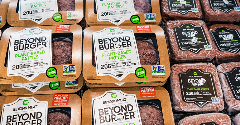News
Colouring Foodstuffs – Clarifying Their Clean Label Contribution
25 Nov 2014While consumers are now tending to approach the term “natural” with more caution with the realisation that there is no legal definition of what it actually means, there is still considerable interest in clean-label, “all-natural” and additive/preservative-free formulations for a wide range of food and drinks products. Just over 18% of total global new food […]

While consumers are now tending to approach the term “natural” with more caution with the realisation that there is no legal definition of what it actually means, there is still considerable interest in clean-label, “all-natural” and additive/preservative-free formulations for a wide range of food and drinks products.
Just over 18% of total global new food and drinks launches recorded by Innova Market Insights in the 12 months to the end of September 2014 had a natural or an additive/preservative-free positioning, or both, up only slightly over a three-year period.
Some sectors of the market lend themselves more readily to a natural positioning, having an inherently natural image, but relatively high levels of activity are also evident for some sectors with a relatively processed image, including ready meals, sauces and seasonings and snack foods. In the soft drinks market, where many juice drinks and water-based lines have a fairly natural image, nearly one-third of the launches recorded were marketed as either natural or additive/preservative-free, or both. However, nearly a quarter of sauces and seasonings and snacks launches and snacks launches also had this type of positioning.
This interest includes growing demand for natural, rather than synthetic, colourings in foods, an area that brings considerable challenges to the food and drinks industry, both technical and regulatory. Demand for naturally-derived colours is growing strongly in Europe in particular, aided by the emergence and development of colouring foodstuff formulations, which are increasingly being favoured over natural colours by manufacturers as they are considered ingredients rather than additives and, as such, do not carry E number classifications and aid clean labelling.
The term ‘colouring foodstuffs’ refers to colouring extracts derived from recognised foods, processed in such a way that the extract retains the raw material’s characteristic properties, such as colour and flavour. Clarification regarding definition and use came into effect via EU Guidance Notes in January 2014 and, from the end of November 2015, no new food products can be launched containing non-compliant colouring foodstuffs.
On the technical front, the stability of natural colouring ingredients has been a key area that companies have been working on, although cost, solubility and variability are also issues. While some colours are relatively easy to develop in natural formulations, others have proved more difficult. Blue is a case in point. Back in the mid-2000s, Nestlé dropped blue Smarties in the UK for over two years as it looked for a natural colouring alternative, only bringing them back in 2008 when a suitable blue colour based on the spirulina algae extract was developed. Spirulina, already relatively well known as a dietary supplement, now finds itself in increasing use as a blue/green food colour across a range of applications, including confectionery and soft drinks.
Likewise, natural anthocyanin- and carotenoid-based colourings from a range of sources, such as grapes, berries, paprika, turmeric, seabuckthorn, tomatoes etc., are also currently at least as well known for promotion of their potential health benefits in terms of antioxidant and vitamin content during the functional foods heyday, but can now be marketed on both benefits.
It seems that for some consumers and sectors of the industry, it may no longer be enough for a colour to be “natural,” with interest moving to colouring foodstuffs, concentrated from foods themselves and often combining natural origins with additional health properties allowing a multi-benefit approach.
Related news

PepsiCo formulates ‘naked’ Cheetos and Doritos products
31 Dec 2025
US food giant PepsiCo has launched its Simply NKD range, a move it says reimagines its popular products with new formulations free from artificial flavours, dyes, and colours.
Read more
Debate over ban on ‘meaty’ names for plant-based products reaches stalemate
26 Dec 2025
The debate over a ban on plant-based products using “meaty” terms has reached a stalemate, leaving manufacturers in limbo and still facing overhauls to their marketing and packaging.
Read more
Has ‘clean’ had its day?
22 Dec 2025
Wielding clean-label positioning and fortification as marketing levers is a dangerous strategy, and brands would be better off explaining the hows and whys of the ingredients in their products, say experts.
Read more
Pioneers of circular plastic packaging push for new policies
18 Dec 2025
Some of the world’s largest food and drink companies have grown frustrated at investing in circular packaging systems, as the majority “wait on the sidelines”.
Read more
Whole Foods Market forecasts fibre frenzy for 2026
11 Dec 2025
Whole Foods Market has released its top 2026 trends, predicting that a fibre frenzy will take place next year as health-conscious consumers seek out nutritious, filling options.
Read more
Sorghum emerges as better-for-you hero ingredient
9 Dec 2025
With the launch of Novak Djokovic’s sorghum-based brand, the grain’s popularity in the better-for-you snacking sphere is on the rise, thanks to its nutritional and sensory properties.
Read more
Innovation promise in 'maturing' plant-based dairy alternatives market
8 Dec 2025
Plant-based dairy is a maturing market that still faces significant hurdles around taste, functionality, nutrition, and price, but industry is innovating fast, according to experts speaking at Fi Europe.
Read more
Turning global trade challenges into opportunities
4 Dec 2025
While our food innovation ecosystem is in a healthy place, certain barriers persist. A panel of experts at Fi Europe shared their ideas and strategies for overcoming these, to fully unleash Europe’s potential.
Read more
Celebrating the winners of the Fi Europe Innovation Awards 2025
3 Dec 2025
Food industry stakeholders celebrated as the winners of the Fi Europe Innovation Awards were announced at a ceremony in Paris.
Read more
Yuka’s food scanning app helps consumers make healthier choices
2 Dec 2025
Global food scanning app Yuka helps consumers understand the content of their shopping baskets and shapes producers’ reformulation plans.
Read more

